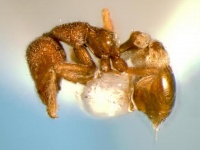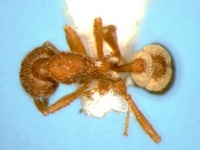Strumigenys kichijo
| Strumigenys kichijo | |
|---|---|

| |
| Scientific classification | |
| Kingdom: | Animalia |
| Phylum: | Arthropoda |
| Class: | Insecta |
| Order: | Hymenoptera |
| Family: | Formicidae |
| Subfamily: | Myrmicinae |
| Tribe: | Attini |
| Genus: | Strumigenys |
| Species: | S. kichijo |
| Binomial name | |
| Strumigenys kichijo (Terayama, Lin & Wu, W.-J., 1996) | |
| Common Name | |
|---|---|
| Kichijou-uroko-ari | |
| Language: | Japanese |
This is a widespread species in Asia, though rarely collected. It has been found in rainforest and rubber plantations and, in Hong Kong, in a secondary forest at a relatively high elevation (572 m) (Tang et al., 2019).
Identification
Bolton (2000) - The only member of the Strumigenys kichijo-group. At present this is the only species known from these regions which has numerous conspicuous standing hairs on the dorsal surface of the mandibles. The sparse samples from different states show some variation in dimensions but agree overall. Nevertheless, it is possible that more than one species is represented here and the group should be reviewed later, when more material is available.
Japan
A rare species similar to Strumigenys masukoi in prossessing abundant flagellate hairs on head and pronotum, but distinguished by the shape of its clypeus (Japanese Ant Image Database).
Keys including this Species
Distribution
Latitudinal Distribution Pattern
Latitudinal Range: 22.26112° to 21.92436111°.
| North Temperate |
North Subtropical |
Tropical | South Subtropical |
South Temperate |
- Source: AntMaps
Distribution based on Regional Taxon Lists
Oriental Region: Bhutan, Taiwan (type locality), Thailand, Vietnam.
Palaearctic Region: China, Japan.
Distribution based on AntMaps
Distribution based on AntWeb specimens
Check data from AntWeb
Countries Occupied
| Number of countries occupied by this species based on AntWiki Regional Taxon Lists. In general, fewer countries occupied indicates a narrower range, while more countries indicates a more widespread species. |

|
Estimated Abundance
| Relative abundance based on number of AntMaps records per species (this species within the purple bar). Fewer records (to the left) indicates a less abundant/encountered species while more records (to the right) indicates more abundant/encountered species. |

|
Biology
|
Castes

| |
| . | |
Nomenclature
The following information is derived from Barry Bolton's Online Catalogue of the Ants of the World.
- kichijo. Smithistruma kichijo Terayama, Lin & Wu, 1996: 335, figs. 23-25, 28, 29 (w.) TAIWAN. Combination in Pyramica: Bolton, 1999: 1673; in Strumigenys: Baroni Urbani & De Andrade, 2007: 122. See also: Bolton, 2000: 427.
Unless otherwise noted the text for the remainder of this section is reported from the publication that includes the original description.
Description
Worker
Bolton (2000) - TL 2.4-2.6, HL 0.56-0.64, HW 0.43-0.48, CI 75-79, ML 0.11-0.14, MI 18-24, SL 0.32-0.36, SI 60-70, PW 0.30-0.33, AL 0.58-0.68 (6 measured).
Dorsal surface of mandible with numerous erect to suberect short curved hairs. Curved standing hairs on clypeal dorsum as long as hairs on vertex immediately behind the posterior clypeal margin. With head in profile the dorsum from posterior clypeal margin to occipital margin with abundant simple hairs that are curved anteriorly in the area immediately behind the clypeus, anteromedially to medially on the remainder of the vertex to its highest point, and curved anteriorly from just behind the highest point to the occipital margin. Close to the occipital margin there are also 2 or more very elongate fine simple hairs that curve forward and are distinct from the main pilosity. Eye with only 5-9 ommatidia in total. With head in full-face view the outer margins of the mandibles with anterolaterally projecting simple short hairs. Dorsolateral margins of head with freely projecting upcurved hairs, similar to those that are numerous on the dorsum and present from the frontal lobes to the occipital corners. Apicoscrobal hair extremely long and fine, curved to flagellate; a second similar hair projects from the margin close to the occipital corner. Upper scrobe margin a bluntly angular rim, not a sharp projecting edge or flange; the scrobe broad and shallow. Clypeal dorsum reticulate-punctate except for the anteromedian area which is smooth, otherwise dorsum of head reticulate-granular everywhere. Dorsal alitrunk reticulate-punctate, the pronotum with traces of sparse minute rugulae. Pleurae and side of propodeum mostly to entirely smooth and shining. Pronotum with medially-curved hairs similar to those on the head, and with a few much longer finer standing hairs. On mesonotum the shorter curved pilosity sparser and the longer finer hairs more numerous. Elongate fine standing hairs present on waist segments and first gastral tergite. Lamellae on propodeum broad and moderately spongiform. Petiole node in dorsal view reticulate-punctate and with a broad posterior collar. Disc of postpetiole smooth medially but laterally with faint traces of weak longitudinal costulae. Spongiform tissue surrounding disc thick laterally and posterolaterally but the posterior collar with a distinct median indentation or gap. Basigastral costulae arise across entire width of tergite, not from each side of a median clear area.
Type Material
Bolton (2000) - Holotype worker, TAIWAN: Taichung Hsien, Kukuan, 1060 m., 30.vii.1988 (no collector's name given). Paratype workers, JAPAN: Okinawa Pref., Okinawa-jima I., Onna-son, Yamada, 20.viii.1994 (M. Terayama, S. Kubota & H. Takamine) (National Institute of Agro-Environmental Sciences, Museum of Nature and Human Activities, National Science Museum (Natural History)) [examined].
References
- Baroni Urbani, C. & De Andrade, M.L. 2007. The ant tribe Dacetini: limits and constituent genera, with descriptions of new species. Annali del Museo Civico di Storia Naturale “G. Doria” 99: 1-191.
- Bolton, B. 1999. Ant genera of the tribe Dacetonini (Hymenoptera: Formicidae). Journal of Natural History. 33:1639-1689. (page 1673, combination in Pyramica)
- Bolton, B. 2000. The ant tribe Dacetini. Memoirs of the American Entomological Institute. 65:1-1028. (page 427, figs. 275, 285 redescription of worker)
- Dendup, K.C., Dorji, C., Dhadwal, T., Bharti, H., Pfeiffer, M. 2021. A preliminary checklist of ants from Bhutan. Asian Myrmecology 14, e014005 (doi:10.20362/am.014005).
- Khachonpisitsak, S., Yamane, S., Sriwichai, P., Jaitrong, W. 2020. An updated checklist of the ants of Thailand (Hymenoptera, Formicidae). ZooKeys 998, 1–182 (doi:10.3897/zookeys.998.54902).
- Ogata, K. and Onoyama, K. 1998. A revision of the ant genus Smithistruma Brown of Japan, with descriptions of four new species (Hymenoptera: Formicidae). Entomological Science. 1(2):277-287. (page 282, see also)
- Tang, K. L., Guénard, B. 2023. Further additions to the knowledge of Strumigenys (Formicidae: Myrmicinae) within South East Asia, with the descriptions of 20 new species. European Journal of Taxonomy 907, 1–144 (doi:10.5852/ejt.2023.907.2327).
- Tang, K.L., Pierce, M.P., Guénard, B. 2019. Review of the genus Strumigenys (Hymenoptera, Formicidae, Myrmicinae) in Hong Kong with the description of three new species and the addition of five native and four introduced species records. ZooKeys 831: 1–48 (DOI 10.3897/zookeys.831.31515).
- Terayama, M.; Lin, C.-C.; Wu, W.-J. 1996. The Taiwanese species of the ant genus Smithistruma (Hymenoptera, Formicidae). Jpn. J. Entomol. 64: 327-339 (page 335, figs. 23-25, 28, 29 worker described)
- Wang, C., Chung, F.-Y., Lin, C.-C., Gibson, J. C., McGuire, S., Suarez, A. V., Billen, J. 2023. The spongiform tissue in Strumigenys ants contains exocrine glands. Arthropod Structure & Development 73, 101246 (doi:10.1016/j.asd.2023.101246).
References based on Global Ant Biodiversity Informatics
- Bolton, B. 2000. The Ant Tribe Dacetini. Memoirs of the American Entomological Institute 65
- Eguchi K.; Bui T. V.; Yamane S. 2011. Generic synopsis of the Formicidae of Vietnam (Insecta: Hymenoptera), part I Myrmicinae and Pseudomyrmecinae. Zootaxa 2878: 1-61.
- Guénard B., and R. R. Dunn. 2012. A checklist of the ants of China. Zootaxa 3558: 1-77.
- Liu C, B. Guénard, F Hita Garcia, S. Yamane, B. Blanchard, and E. Economo. New records of ant species from Yunnan, China. Submitted to Zookeys
- Ogata K. and Onoyama K. 1998. A Revision of the Ant Genus Smithistruma Brown of Japan, with Descriptions of Four New Species (Hymenoptera: Formicidae). Entomological Science 1: 277-287
- Terayama M. 2009. A synopsis of the family Formicidae of Taiwan (Insecta: Hymenoptera). Research Bulletin of Kanto Gakuen University. Liberal Arts 17:81-266.
- Terayama M., C. C. Lin, and W. J. Wu. 1996. The Taiwanese species of the ant genus Smithistruma (Hymenoptera, Formicidae). Japanese Journal of Entomology 64: 327-339.
- Terayama M., S. Kubota, and K. Eguchi. 2014. Encyclopedia of Japanese ants. Asakura Shoten: Tokyo, 278 pp.
- Terayama, M. 2009. A synopsis of the family Formicidae of Taiwan (Insecta; Hymenoptera). The Research Bulletin of Kanto Gakuen University 17: 81-266.
- Xu Z. H., and X. G. Zhou. 2004. Systematic study on the ant genus Pyramica Roger (Hymenoptera, Formicidae) of China. Acta Zootaxonomica Sinica 29: 440-450.
- Xu Z. and X.-G. Zhou. 2004. Systematic study on the ant genus Pyramica Roger (Hymenoptera, Formicidae) of China. Acta Zootaxonomica Sinica 29(3): 440-450
- Yamane S., S. Ikudome, and M. Terayama. 1999. Identification guide to the Aculeata of the Nansei Islands, Japan. Sapporo: Hokkaido University Press, xii + 831 pp. pp, 138-317.
- Yamane S.; Ikudome, S.; Terayama, M. 1999. Identification guide to the Aculeata of the Nansei Islands, Japan. Sapporo: Hokkaido University Press, xii + 831 pp. pp138-317.

